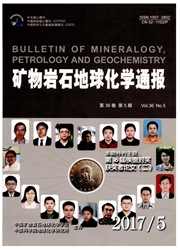

 中文摘要:
中文摘要:
为理解富钴结壳结构与成因之间的内在联系,基于扩散限制聚集模型,初步构建了富钴结壳胶体沉淀的动力学模型,并模拟了富钴结壳结构的形成过程。模拟结果显示,扩散胶体粒子与沉淀胶体粒子碰撞后,当两者相互吸附的方位角没有选择性时形成树枝状结构;当胶粒浓度与碰撞反应概率大时,形成均一的致密结构,而当碰撞反应概率降低时,则形成柱状结构;胶粒吸附次序与垂向深度呈较显著的正相关关系。模拟结果表明,树枝状结构形成内因在于胶粒间吸附结合的方式;水平纹层结构形成条件为海水中具较高的Fe、Mn胶体粒子的浓度,而致密或疏松的树枝状结构形成于较低的胶体粒子碰撞反应概率条件;对于构成富钴结壳主体框架的Fe和Mn来说,富钴结壳基本上是一个封闭的系统。
 英文摘要:
英文摘要:
In order to clarify the underlying relationship between the texture of Co-rich ferromanganese crust and its origin,we proposed a colloidal aggregation dynamic model for Co-rich ferromanganese crust to simulate the formation of its texture on the basis of the Diffusion-Limited Aggregation( DLA) model. The results showed that the dendritic texture was formed when diffusing colloidal particles collided with precipitated ones at random directions; the homogeneous dense texture was formed when the concentration of colloidal particle and the probability of collision were high,while the dense columnar texture was formed when the probability of collision decreased; the deposition sequence of particles was found to be positively correlated with thickness. The simulation indicated that the dendritic texture was resulted from the adsorption manner of particles; the plausible conditions for the formation of laminated texture should be high Fe and Mn colloidal particle concentrations in the seawater; the low collision probability of colloidal particles might result in the formation of dense / loose dendritic texture; the Co-rich ferromanganese crust was a basically closed system for Fe and Mn who constitute the texture frame of the crust.
 同期刊论文项目
同期刊论文项目
 同项目期刊论文
同项目期刊论文
 期刊信息
期刊信息
